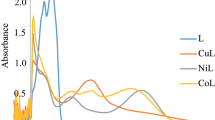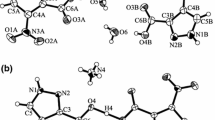Abstract
Two tetradentate ligands, 1,2-bis(2-hydroxyethylthio)ethane S2O2 (L 1) and N,N′-bis(2-hydoxypropyl)piperazine N2O2 (L 2), were prepared by organization of some mononuclear complexes of Cu(II) and Ni(II). A new binuclear Schiff base ligand with a 1,4-dipropoxybutane spacer provided by the reaction of salicylaldehyde and 1,4-bis(3-aminopropoxy)butane served as an octadentate, N2O4 (L 3) ligand, in designing some binuclear complexes with metal ions. All the ligands were characterized by elemental analyses, FTIR, 1H and 13C NMR and GC–MS. The complexes were characterized by elemental analyses, FTIR, thermal methods, electronic spectra, conductivity and magnetic measurements. The metal ions coordinate to the ligands with four donor atoms in square planar geometry. The thermal stabilities of the complexes were discussed in terms of metal ions and type of donor atoms. The complexes were characterized by electronic spectra and magnetic susceptibility measurements to establish the proposed four-coordinated square planar geometry. The TG chart indicates high thermal stability for complexes. The decomposition processes consisted of three stages: The first two stages involve the loss of water and chloride anions and the last stage indicates degradation of the organic ligands. The antifungal activity of the ligands and their complexes was tested against several fungal species: Aspergillus nigar, Aspergillus flavus and Candida albicans. The results show that complexes have significant antifungal activities compared to their parent ligands.










Similar content being viewed by others
References
Trujillo A, Sinbandhit S, Toupet L, Carrillo DV, Manzur C, Hamon JR. Organometallic–inorganic conjugated unsymmetrical schiff-base hybrids. Synthesis, characterization, electrochemistry and X-ray crystal structures of functionalized trinuclear iron–nickel–ruthenium dipolar chromophores. J Inorg Organomet Polym. 2008;18:81–99.
Lozan V, Loose C, Kortus J, Kersting B. Coordination chemistry of Robson-type polyamine-dithiophenolate macrocycles: syntheses, structures and magnetic properties of dinuclear complexes of first-row transition metals. Coord Chem Rev. 2009;253:2244–60.
Ali MA, Mırza AH, Nazimuddin M, Karim F, Bernhardt PV. Synthesis, characterization and X-ray crystal structures of dinuclear nickel(II) complexes of a novel potentially hexadentate but functionally tetradentate binucleating ligand. Inorg Chim Acta. 2005;358:4548–54.
Sallam SA. Binuclear copper(II), nickel(II) and cobalt(II) complexes with N2O2 chromophores of glycylglycine Schiff-bases of acetylacetone, benzoylacetone and thenoyltrifluoroacetone. Trans Met Chem. 2006;31:46–55.
Jeragh BJA, El-Dissouky AJ. Synthesis, spectroscopic and the biological activity studies of thiosemicarbazones containing ferrocene and their copper(II) complexes. Coord Chem. 2005;58:1029–38.
Vigato PA, Tanburini S. The challenge of cyclic and acyclic schiff bases and related derivatives. Coord Chem Rev. 2004;248:1717–2128.
Ligtenbarg AGJ, Beuken EK, Meetsma A, Veldman N, Smeets WJJ, Spek AL, Feringa BL. New mono- and di-nuclear complexes of PdII, PtII and NiII of PNNP ligands with a 2,2′-biaryl bridging unit. J Chem Soc, Dalton Trans. 1998;2:263–70.
Mac-Leod TCO, Guedes DFC, Lelo MR, Rocha RA, Caetano BL, Ciuffi KJ, Assis MD. Catalytic activity of Jacobsen catalyst encapsulated in an alumina matrix by the sol–gel process. J Mol Catal A: Chem. 2006;259:319–27.
Patole J, Shingnapurkar D, Padhye S, Ratledge C. Schiff base conjugates of p-aminosalicylic acid as antimycobacterial agents. Bioorg Med Chem Lett. 2006;16:1514–7.
Singh HL, Sharma M, Varshney AK. Studies on coordination compounds of organotin(IV) with Schiff bases of amino acids. Synth React Inorg Met Org Chem. 2000;30:445–56.
Nath M, Pokharia S, Yadav R. The challenge of cyclic and acyclic schiff bases and related derivatives. Coord Chem Rev. 2001;215:99–149.
Lv J, Liu T, Cai S, Wang X, Liu L, Wang Y. Synthesis, structure and biological activity of cobalt(II) and copper(II) complexes of valine-derived schiff bases. J Inorg Biochem. 2006;100:1888–96.
Di Bella S, Fragala I, Ledoux I, Marks TJ. Role of metal electronic properties in tuning the second-order nonlinear optical response of coordination complexes. A combined experimental and theoretical investigation of a homologous series of (N,N′-disalicylidene-1,2-phenylenediaminato)M(II) (M = Co, Ni, Cu) complexes. J Am Chem Soc. 1995;117:9481–5.
Lacroix PG, DiBella S, Ledoux I. Synthesis and second-order nonlinear optical properties of new copper(II), nickel(II), and zinc(II) Schiff-base complexes. Toward a role of inorganic chromophores for second harmonic generation. Chem Mater. 1996;8:541–5.
Lenoble G, Lacroix PG, Daran JC, Di Bella S, Nakatani K. Syntheses, crystal structures, and NLO properties of new chiral inorganic chromophores for second-harmonic generation. Inorg Chem. 1998;37:2158–65.
Turkyilmaz M, Baran Y, Ozdemir N. 1,1-(Piperazine-1,4-diyl)dipropan-2-ol. Acta Crystallogr E. 2011;67:o1758.
Akbar AM, Livingstone SE. Metal complexes of sulphur-nitrogen chelating agents. Coord Chem Rev. 1974;13:101–32.
Zhou X, Shao L, Zhong JZ, Liu JB, Dai H, Fang JX. Synthesis and antitumor activity evaluation of some schiff bases derived from 2-aminothiazole derivatives. Heteroat Chem. 2007;18:55–9.
Mital SP, Sharma SK, Singh RV, Tandon JP. Antifungal activity of some novel lanthanon thiosemicarbazone complexes. Curr Sci. 1981;50:483–5.
Shipman C, Smith SH, Drach JC, Klayman DL. Antiviral activity of 2-acetylpyridine thiosemicarbazones against herpes simplex virus. Antimicrob Agent Chemother. 1981;19:682–5.
Dobak AS, Klyman DL, Dickson ET, Scovill JP, Tramont EC. Inhibition of clinically significant bacterial organisms in vitro by 2-acetylpyridine thiosemicarbazones. Antimicrob Agents Chemother. 1980;18:27–36.
Reedijk J, Bouman E. Bioinorganic catalysis. New York: Marcel Dekker; 1999. p. 231.
Hausinger RP. Biochemistry of nickel. New York: Plenum Press; 1993. p. 23.
Kumar A, Kumar D. Synthesis and antimicrobial activity of metal complexes from 2-(1′/2′-hydroxynaphthyl) benzoxazoles. Arkivoc. 2007;14:117–25.
Zhao PS, Wang HY, Song J, Lu LD. Synthesis, structures, and property studies on Zn(II), Ni(II), and Cu(II) complexes with a Schiff base ligand containing thiocarbamide group. Struct Chem. 2010;21:977–87.
Zhang SS, Yin XH, Hu FL, Zhuang Y. Synthesis, spectral, and thermal properties, and crystal structure of cobalt(III) complex derived from Imazameth. Struct Chem. 2010;21:79–85.
Shit S, Chakraborty J, Samanta B, Slawin AMZ, Gramlich V, Mitra S. Three new coordination complexes of cobalt(III), manganese(II), and copper(II) with N,N,O-donor hydrazone ligands: syntheses and structural characterizations. Struct Chem. 2009;20:633–42.
Wang H, Zhao P, Shao D, Zhang J, Zhu Y. Synthesis, characterization and spectra studies on Zn(II) and Cu(II) complexes with thiocarbamide ligand containing Schiff base group. Struct Chem. 2009;20:995–1004.
Basak S, Sen S, Mitra S, Marschner C, Sheldrick WS. Square planar complexes of Cu(II) and Ni(II) with N2O donor set of two Schiff base ligands: synthesis and structural aspects. Struct Chem. 2008;19:115–21.
Patel SH, Pansuriya PB, Chhasatia MR, Parekh HM, Patel MN. Coordination chain polymeric assemblies of trivalent lanthanides with multidentate Schiff base synthetic, spectral investigation and thermal aspects. J Therm Anal Calorim. 2008;91:413–8.
Fan YH, Gao ZX, Bi CF, Xie ST, Zhang X. Synthesis and thermal decomposition kinetics of La(III) complexwith unsymmetrical Schiff base ligand. J Therm Anal Calorim. 2008;91:919–23.
Lalia-Kantouri M, Tzavellas L, Paschalidis D. Novel lanthanide complexes with di-2-pyridyl ketone-p-chloro-benzoylhydrazone. J Therm Anal Calorim. 2008;91:937–42.
Singh K, Barwa MS, Tyagi PE. Synthesis, characterization and biological studies of Co(II), Ni(II), Cu(II) and Zn(II) complexes with bidentate Schiff bases derived by heterocyclic ketone. Eur J Med Chem. 2006;41:147–53.
Timperley CM, Black RM, Bird M, Holden I, Mundy JL, Read RW. Hydrolysis and oxidation products of the chemical warfare agents 1,2-bis[(2-chloroethyl)thio]ethane Q and 2,2-bis(2-chloroethylthio)diethyl ether T. Phosphorus, Sulfur Silicon Relat Elem. 2003;78(9):2027–46.
Paul K, Blanton DW Jr. 1,4-Bis(6-methoxy-8-quinolylaminoalkyl)piperazines as potential prophylactic antimalarial agents. J Med Chem. 1973;16:1391–4.
Zayed EM, Mohamed GG, Hindy AMM. Transition metal complexes of novel Schiff base. J Therm Anal Calorim. 2015;120:893–903.
Olar R, Badea M, Ferbinteanu M, Stanica N, Alan I. Spectral, magnetic and thermal characterization of new Ni(II), Cu(II), Zn(II) and Cd(II) complexes with a bischelate Schiff base. J Therm Anal Calorim. 2016;. doi:10.1007/s10973-016-5433-7.
Hathaway BJ, Billing DE. The electronic properties and stereochemistry of mono-nuclear complexes of the copper(II) ion. Coord Chem Rev. 1970;5:143–207.
Emam SA, AbouEl-Enein SA, Emara EM. Spectroscopic studies and thermal decomposition for (bis-((E)-2-(4-ethylphenylimino)-1,2-diphenylethanone) Schiff base and its Co(II), Ni(II), Cu(II), Zn(II) and Cd(II) complexes prepared by direct and template reactions. J Therm Anal Calorim. 2016;. doi:10.1007/s10973-016-5835-6.
Chattopadhyay S, Ray MS, Chaudhuri S, Mukhopadhyay G, Bocelli G, Cantoni A, Ghosh A. Nickel(II) and copper(II) complexes of tetradentate unsymmetrical Schiff base ligands: first evidence of positional isomerism in such system. Inorg Chem Acta. 2006;359:1367–75.
Ray MS, Chaudhuri S, Right L, Bocelli G, Mukhopadhyay G, Ghosh A. Synthesis, characterisation and X-ray crystal structure of copper(II) complexes with unsymmetrical tetradentate Schiff base ligands: first evidence of Cu(II) catalysed rearrangement of unsymmetrical to symmetrical complex. Polyhedron. 2003;22:617–24.
Salib KAR, El-Sayed SM, El-Shabing AM. Preparation and properties of metal complexes with new asymmetric pentadentate Schiff base ligands. Synth React Inorg Met Org Chem. 1991;21:1511–27.
Garg BS, Kumar DN. Spectral studies of complexes of nickel(II) with tetradentate schiff bases having N2O2 donor groups. Spectrochim Acta A. 2003;59:229–34.
Bigoli F, Cassoux P, Deplano P, Mercuri ML, Pellinghelli MA, Pintus G, Serpe A, Trogu EF. Synthesis, structure and properties of new unsymmetrical nickel dithiolene complexes useful as near-infrared dyes. J Chem Soc, Dalton Trans. 2000;24:4639–44.
Bal S, Orhan B, Connolly JD, Digrak M, Koytepe S. Synthesis and characterization of some Schiff bases, their metal complexes and thermal, antimicrobial and catalytic features. J Therm Anal Calorim. 2015;121:909–17.
Geary WJ. The use of conductivity measurements in organic solvents for the characterisation of coordination compounds. Coord Chem Rev. 1971;7:81–122.
Bartyzel A. Synthesis, thermal study and some properties of N2O4-donor Schiff base and its Mn(III), Co(II), Ni(II), Cu(II) and Zn(II) complexes. J Therm Anal Calorim. 2016;. doi:10.1007/s10973-016-5804-0.
Lal S, Arora S, Sharma C. Synthesis, thermal and antimicrobial studies of some Schiff bases of chitosan. J Therm Anal Calorim. 2016;124:909–16.
Acknowledgments
The author thanks Professor Yakup BARAN for his help.
Author information
Authors and Affiliations
Corresponding author
Electronic supplementary material
Below is the link to the electronic supplementary material.
Rights and permissions
About this article
Cite this article
Turkyilmaz, M. Binuclear and mononuclear Cu(II) and Ni(II) complexes of tetra- and hexadentate ligands. J Therm Anal Calorim 129, 451–460 (2017). https://doi.org/10.1007/s10973-017-6187-6
Received:
Accepted:
Published:
Issue Date:
DOI: https://doi.org/10.1007/s10973-017-6187-6




